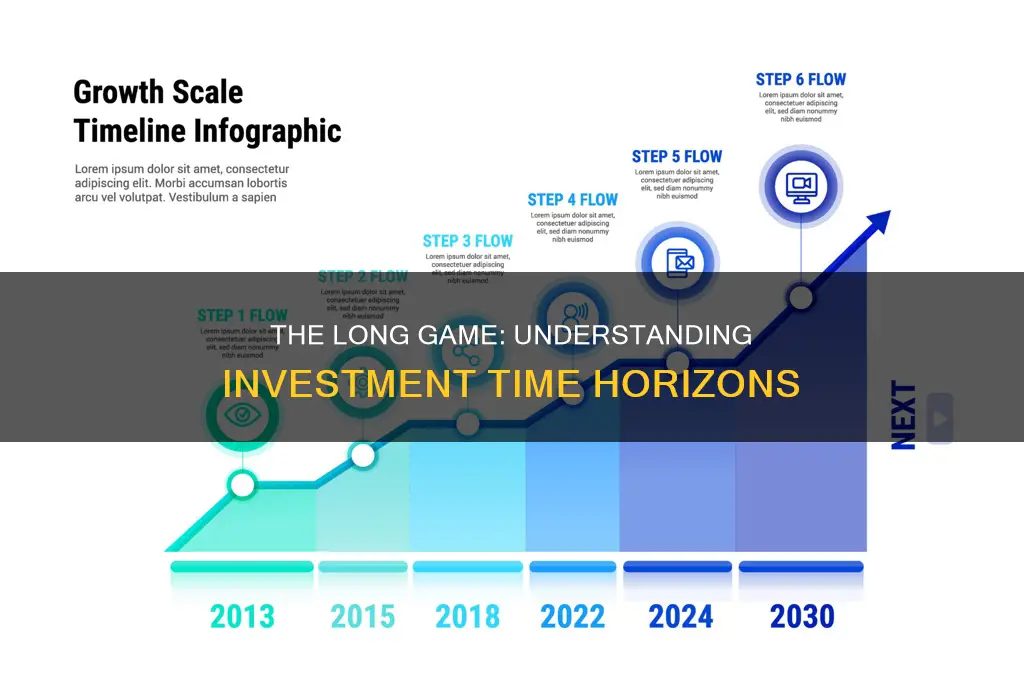
There are many variables to consider when determining how long it will take for an investment to grow. The volatility of stock returns means that you can only estimate how long your investment will take to grow. To calculate this, you need to know the annual rate of return. However, since returns are almost never guaranteed, the actual amount of time it takes to reach your goal may change depending on how your investments perform. There are various online tools and formulas, such as the Rule of 72, that can help you estimate how long it will take for your investment to grow.
| Characteristics | Values |
|---|---|
| Rule of 72 | A formula used to estimate the number of years required to double the invested money at a given annual rate of return |
| Rule of 72 accuracy | Most accurate for rates of return between 6% and 10% |
| Rule of 72 alternatives | Rule of 69, Rule of 70, Rule of 73 |
| Will the Money Last calculator | Allows users to compare two scenarios considering a starting balance, rate of return, income, and inflation |
What You'll Learn

The Rule of 72: a formula to estimate years to double investment
The Rule of 72 is a formula used to estimate the number of years required for an investment to double in value, or alternatively, to compute the annual rate of compounded return from an investment given the number of years it will take to double. It is calculated by dividing 72 by the expected rate of return, or dividing 72 by the number of years to double to find the expected rate of return.
The Rule of 72 is a simplified formula that is useful for quick, approximate mental calculations. It is most accurate for interest rates that fall in the range of 6% to 10%. For example, if an investment scheme promises an 8% annual compounded rate of return, it will take approximately nine years (72 / 8 = 9) to double the money.
The Rule of 72 can also be used to estimate the rate of return needed for an investment to double given an investment period. For instance, if you want to double your money in eight years, divide 72 by eight, which means you will need an average annual return of 9% (72 / 8 = 9%).
The Rule of 72 can be applied to anything that grows at a compounded rate, such as population, macroeconomic numbers, charges, or loans. It can also be used to find out how long it takes for the value of money to halve due to inflation.
While the Rule of 72 is a useful estimation tool, it is important to note that it is not entirely precise. For more precise outcomes, the Rule of 69.3 or 70 can be used, which are more accurate for continuous compounding.
Retirement Strategies: Navigating the Rebalancing Act
You may want to see also

Calculating growth rates at the University of Oregon
There are a few ways to calculate growth rates, which refer to the percentage change of a specific variable within a given time period. Growth rates can be positive or negative, indicating whether the variable is increasing or decreasing over time.
Percent (Straight-Line) Growth Rates
The percent change from one period to another is calculated using the formula:
PR = Percent Rate
VPresent = Present or Future Value
VPast = Past or Present Value
The annual percentage growth rate is the percent growth divided by N, the number of years.
For example, if a county's population grew from 250,000 to 280,000 over 10 years, the annual percentage growth rate is 1.2%.
Average Annual (Compound) Growth Rates
The Average Annual or Compound Growth Rate (AAGR) is another common method of calculating rates of change. It works like a typical savings account, with interest compounded for some period (usually daily or monthly) at a given rate.
Let's say you invest $100 in an account with 5% annual interest. To calculate your future balance, use the formula:
Future Value = $100 * (1.05)^5 = $127.6
Compound Annual Growth Rate (CAGR)
The Compound Annual Growth Rate (CAGR) is a variation on the growth rate used to assess an investment's or company's performance. It assumes that growth is steady over a specified period of time. The formula for calculating CAGR is:
CAGR = ((EV/BV)^(1/n)) - 1
Where:
EV = Ending Value
BV = Beginning Value
N = Number of Years
Rule of 72
The Rule of 72 is a shortcut investors can use to determine how long it will take their investment to double based on a fixed annual rate of return. Divide 72 by the fixed rate of return to get the number of years it will take for your initial investment to double.
For example, if your investment earns 6% per year on average, it will take 12 years for your money to double.
Solar Energy: Invest or Not?
You may want to see also

Using a compound interest calculator
There are several free online compound interest calculators available, such as the ones offered by investor.gov and NerdWallet. These calculators can help you determine how much your money can grow and how increasing your savings rate will impact your long-term returns.
To use a compound interest calculator, you will need to input certain information, such as:
- Initial deposit or principal amount
- Contribution amount, if you plan to make additional contributions
- Contribution frequency, such as monthly or annually
- Years of growth or the time frame for your investment
- Estimated rate of return or annual yield
- Compound frequency, such as daily, monthly, or annually
For example, let's say you want to invest $10,000 in a high-yield savings account with a 5% annual yield, compounded daily, and you don't plan to make any additional contributions. After inputting this information into the calculator, you will find that you will earn $512.67 in interest after the first year. If you leave your money in the account for another year, you will earn $538.96 in interest in the second year, for a total of $1,051.63 in interest over two years.
By using a compound interest calculator, you can see the power of compound interest and how it can help your savings or investments grow over time. It is a useful tool for financial planning and can help you make informed decisions about your money.
Middle-Aged Investors: Security and Growth
You may want to see also

The Rule of 70: a calculation for investment value doubling
The Rule of 70 is a calculation that determines how many years it takes for an investment to double in value based on a constant rate of return. It is calculated by dividing the number 70 by the investment's growth rate. For example, at a 3% growth rate, a portfolio will double in 23.33 years because 70/3 = 23.33. At an 8% growth rate, a portfolio will double in 8.75 years because 70/8 = 8.75. At a 12% growth rate, a portfolio will double in 5.8 years because 70/12 = 5.8.
The Rule of 70 is often used to compare different investments and their rates of return. It is also used to evaluate the investment returns of mutual funds and retirement portfolios. The calculation is commonly used to compare investments with different annual interest rates.
The Rule of 70 is a rough estimate that assumes a constant growth rate that may fluctuate, and the calculation may prove inaccurate. It is most accurate for rates of return between 5% and 10%. The Rule of 70 is useful for mental calculations and when only a basic calculator is available.
The Rule of 70 is similar to the Rule of 72, which is used more commonly in finance to determine how long it will take an investment to double with a fixed interest rate. The Rule of 72 leads to longer doubling times, making it a slightly more conservative estimate. The Rule of 69 is also similar and is often considered more accurate when addressing continuous compounding processes.
Small Investments, Big Returns
You may want to see also

Retirement planning: comparing investment scenarios
Retirement planning is about creating a roadmap to a financially comfortable life after work. It involves determining your long-term financial goals and tolerance for risk, and then taking action to reach those goals. The earlier you start, the better.
- Systematic Withdrawal Strategy: This strategy involves selling off investments each year from a portfolio of bonds, CDs, stocks, mutual funds, etc., to generate income. It seeks to balance risk and returns by rebalancing investments over time while providing a steady, inflation-adjusted cash flow. The withdrawal rate is based on risk tolerance, investment returns, and time horizon. The upside is the potential for long-term market investment gains, but the drawback is the risk of market downturns, especially during the first few years of retirement.
- Flooring Retirement Income Strategy: This strategy prioritizes essential expenses (needs) over discretionary expenses (wants). It aims to provide a secure income by using products like Social Security, pensions, annuities, or a bond/TIPS ladder. The downside is that this strategy may result in lower wealth growth compared to a systematic withdrawal approach. However, it offers security and is suitable for those who are more risk-averse.
- Time Segmentation Strategy (Bucket Approach): This strategy involves creating different investment buckets for various time horizons in retirement. The first bucket, for the near term (e.g., the first five years), is funded by safe income sources like cash, bonds, CDs, and term annuities. The second bucket has a mixed investment allocation, providing growth potential but with reduced market risk. The third bucket, for the long term (over 10 years), is invested entirely in stocks for higher returns. The challenge with this approach is determining when to refill the buckets as they empty. This strategy appeals to individuals who want a clear picture of their investment plan and why they are investing in the market.
Retirement planning tools and calculators can help you compare different scenarios by taking into account various factors such as retirement age, work income, longevity, taxes, Social Security start age, savings rates, expenses, investment returns, and inheritance. These tools enable you to assess the trade-offs and make more informed decisions about your financial future.
Additionally, the Rule of 72 provides a simple way to estimate how long it will take for your investment to double based on a fixed annual rate of return. By dividing 72 by the rate of return, you can determine the number of years needed for your investment to double. For example, at a 10% annual return, your money will double in a little over seven years.
Remember, retirement planning is a dynamic process, and it's important to update and review your plan periodically to ensure you're on track to achieve your financial goals.
Blackberry Stock: Why the Hype?
You may want to see also
Frequently asked questions
You can use the formula for calculating the future value of a present amount, Future Value = Present Value * (1 + Interest Rate) ^ Number of Years, to estimate how long it will take for your investment to reach a certain value.
The Rule of 72 is a shortcut to estimate how long it will take for your investment to double based on a fixed annual rate of return. You can divide 72 by the expected rate of return to get the number of years it will take for your initial investment to double.
Yes, there are online tools and calculators available, such as the "Will the Money Last Calculator", which can help you estimate how long your money will provide you with an annual income, taking into account factors like starting investment balance, rate of return, income, and inflation.
Compound interest is calculated on both the initial principal and the accumulated interest of previous periods of a deposit. This means that your investments can grow exponentially over time, especially with higher interest rates or longer investment periods.
Yes, the volatility of stock returns and the fact that returns are not guaranteed can affect the growth of your investments. Additionally, factors like inflation, fees, and changing rates of return can also impact the timeline for your investments to reach certain values.







